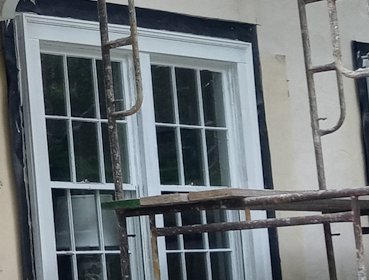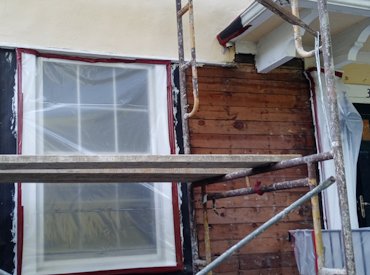Real stucco on Foxhall Road
Washington,DC
Here's how we did it:

Stucco was cut off around windows to allow new window trim to be put on by carpenters. Carpentry by Beauchain builders. Tarpaper was put under trim.

Note the loose stucco was taken off below porch roof for typical reasons, namely lack of kickout flashing and counter flashing over the stucco.

Step flashing was repaired and a new counter flashing put on and sealed with red tape..

Protecto tape is folded over the back side of the trim to seal the back side of the trim. Flashing with a steep angle is put over window. Keeping water out of the house by caulking around the window after the stucco is done is absurd.

When the roof was replaced last they re-used the original step flashing. What a mess.

A new counter flashing is put on and stucco is overlapped on the top flange.

We put on a new apron flashing, which didn't cover the row of holes left by whoever put on the old apron flashing. They apparently re-used the original apron flashing.

We corrected this hole problem by covering the holes with a strip of black metal, tucking the metal under the new apron flashing.

Areas where stucco was removed were filled with new lath and cement mortar. Walls are chipped and loose finish coat mortar is removed.

Walls are coated with a thin basecoat with plenty of acrylic bonding admixture.

REAL white portland cement and REAL white sand are dry mixed in a mortar box.

Color is mixed in a garbage can with half and half water and acrylic.

Sure looks better than that synthetic (fake) finish, which is a rubbery paint with plastic sand.

Natural cement color finish lights up this deserving old house.














